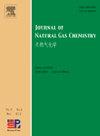Nickel ferrite spinel as catalyst precursor in the dry reforming of methane: Synthesis, characterization and catalytic properties
Abstract
Dry reforming of methane by CO2 using nickel ferrite as precursor of catalysts was investigated. Nickel ferrite crystalline particles were prepared by coprecipitation of nitrates with NaOH or ammonia followed by calcination, or by hydrothermal synthesis without calcination step. The textural and structural properties were determined by a number of analysis methods, including X-ray diffraction (XRD), Raman spectroscopy and X-ray photoelectron spectroscopy (XPS), among which X-ray diffraction (XRD) was at room and variable temperatures. All synthesized oxides showed the presence of micro or nanoparticles of NiFe2O4 inverse spinel, but Fe2O3 (hematite) was also present when ammonia was used for coprecipitation. The reducibility by hydrogen was studied by temperature-programmed reduction (TPR) and in situ XRD, which showed the influence of the preparation method. The surface area (BET), particle size (Rietveld refinement), as well as surface Ni/Fe atomic ratio (XPS) and the behavior upon reduction varied according to the synthesis method. The catalytic reactivity was investigated using isopropanol decomposition to determine the acid/base properties. The catalytic performance of methane reforming with CO2 was measured with and without the pre-treatment of catalysts under H2 in 650-800 °C range. The catalytic conversions of methane and CO2 were quite low but they increased when the catalysts were pre-reduced. A significant contribution of reverse water gas shift reaction accounted for the low values of H2/CO ratio. No coking was observed as shown by the reoxidation step performed after the catalytic reactions. The possible formation of nickel-iron alloy observed during the study of reducibility by hydrogen was invoked to account for the catalytic behavior.

 求助内容:
求助内容: 应助结果提醒方式:
应助结果提醒方式:


